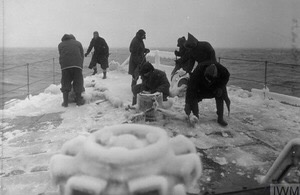As Britain marks 75 years after they first set sail, what were the Arctic Convoys?
Two years into the Second World War, the Soviet Union was under enormous pressure and in need of supplies.
When Germany invaded on 22 June 1941, the Soviet leader, Joseph Stalin, asked for help from Britain and her allies.
Providing much-needed supplies would not be easy, with many sea routes defended by Nazi Germany. The most direct route was through the Arctic Circle by sea, around northern Norway to the Soviet ports of Murmansk and Archangelsk.
The treacherous route passed through a narrow channel between the Arctic ice pack and the Norwegian coast dotted with German naval ports. This course was extremely dangerous, especially in winter when the ice pack swells in size and creeps further south.
The first convoy set sail from Liverpool on 12 August 1941, headed for Iceland where it departed on 21 August, and finally arrived in Arkhangelsk 10 days later. Codenamed Operation ‘Dervish’, the convoy delivered 48 RAF Hurricane fighters for the defence of Polyarnoe and Murmansk. Shortly after, the first Anglo-Soviet Protocol was signed, detailing the materials to be shipped to the USSR.
For the next four years, 78 convoys made the journey to Russia. Conditions were among the worst faced by any Allied sailors. As well as facing the Nazi German Navy, they battled extreme temperatures, gales and pack ice. Eighty-five merchant vessels and 16 Royal Navy warships (two cruisers, six destroyers, eight other escort ships) were lost.
For the first two years, the convoys had to contend with appalling conditions caused by plunging temperatures and hostile seas.
The Germans however appeared to be slightly distracted, focusing their attentions on their Army’s move towards Moscow, a front where Navy influence played no direct role.
By the end of 1941 a third of a million tons of supplies had been delivered to Archangel and Murmansk – for the loss of just one of the 57 eastbound merchant ships and one escorting destroyer, both sunk as chance encounters with U-boats. This good fortune ended in late March 1942, when the Germans at last turned their attentions to sending aircraft, U-boats and a destroyer flotilla against the 19 British ships. Five ships were lost and the German Navy began to make the convoys’ task much more difficult.
The convoys suffered a heavy setback in July 1942 when they suffered a week of heavy attacks by the Germans. Convoy codenamed PQ17 was almost completely destroyed – 24 of the 35 merchant vessels were sunk with the loss of 153 mariners. The 35 ships and six naval auxiliaries making up the convoy contained 297 aircraft, 594 tanks, 4,246 vehicles and gun carriers, and more than 156,000 tons of additional cargo, enough to equip five Soviet divisions.
Only 10 ships and four auxiliaries reached their destination. Prime Minister Churchill later wrote it was “one of the most melancholy naval episodes in the whole of the war”.
The Arctic convoy route was about twice as long as that for the Mediterranean convoys and while the Mediterranean sea can sometimes be choppy, its waters are mostly calm and mild compared with the freezing Arctic circle where shipping conditions are notoriously dangerous. Both routes were constrained by geographic barriers – land in the Mediterranean and ice in the Arctic.
There was far less room for the convoys to take evasive action, therefore, when compared with the vast Atlantic tract. The result was that most of the Arctic and Mediterranean convoys were attacked.
The Germans were able to disrupt the passage of convoys to Russia, in part by exploiting the winter darkness which inhibited reconnaissance. Of the ships which sailed during the Arctic Convoys, 5.7 per cent were lost compared with the overall convoy loss during the war of 0.33 per cent. Over the years 1941-45 an estimated 3,000 sailors lost their lives.
Although the supplies were valuable, an additional contribution made by the Arctic convoys was political. They proved that the Allies were committed to helping the Soviet Union and they also tied up a large part of Germany’s dwindling naval and air forces.
As well as tanks and aircraft, these included less sensational but still vital items like trucks, tractors, telephone wire, railway engines and boots. In spite of the efforts of the German Navy, as well as all that the sea could throw at them, between 1941 and 1945 the convoys delivered more than four million tons of supplies to the Russians.







